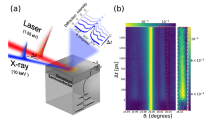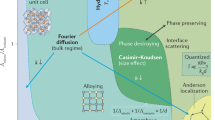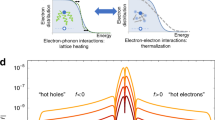Abstract
Fourier theory of thermal transport considers heat transport as a diffusive process where energy flow is driven by a temperature gradient. However, this is not valid at length scales smaller than the mean free path for the energy carriers in a material, which can be hundreds of nanometres in crystalline materials at room temperature. In this case, heat flow will become ‘ballistic’—driven by direct point-to-point transport of energy quanta 1. Past experiments have demonstrated size-dependent ballistic thermal transport through nanostructures such as thin films, superlattices, nanowires and carbon nanotubes1,2,3,4,5,6,7,8. The Fourier law should also break down in the case of heat dissipation from a nanoscale heat source into the bulk. However, despite considerable theoretical discussion and direct application to thermal management in nanoelectronics2, nano-enabled energy systems9,10 and nanomedicine11, this non-Fourier heat dissipation has not been experimentally observed so far. Here, we report the first observation and quantitative measurements of this transition from diffusive to ballistic thermal transport from a nanoscale hotspot, finding a significant (as much as three times) decrease in energy transport away from the nanoscale heat source compared with Fourier-law predictions.
This is a preview of subscription content, access via your institution
Access options
Subscribe to this journal
Receive 12 print issues and online access
$259.00 per year
only $21.58 per issue
Buy this article
- Purchase on Springer Link
- Instant access to full article PDF
Prices may be subject to local taxes which are calculated during checkout




Similar content being viewed by others
References
Chen, G., Borca-Tasciuc, D. & Yang, R. G. Nanoscale heat transfer. Encyclopedia Nanosci. Nanotechnol. 7, 429–459 (2004).
Pop, E., Sinha, S. & Goodson, K. E. Heat generation and transport in nanometer-scale transistors. Proc. IEEE 94, 1587–1601 (2006).
Capinski, W. S. et al. Thermal-conductivity measurements of GaAs/AlAs superlattices using a picosecond optical pump-and-probe technique. Phys. Rev. B 59, 8105–8113 (1999).
Ju, Y. S. & Goodson, K. E. Phonon scattering in silicon films with thickness of order 100 nm. Appl. Phys. Lett. 74, 3005–3007 (1999).
Chen, R. et al. Thermal conductance of thin silicon nanowires. Phys. Rev. Lett. 101, 105501 (2008).
Chiritescu, C. et al. Ultralow thermal conductivity in disordered, layered WSe2 crystals. Science 315, 351–353 (2007).
Hochbaum, A. I. et al. Enhanced thermoelectric performance of rough silicon nanowires. Nature 451, 163–167 (2008).
Chang, C. W., Okawa, D., Garcia, H., Majumdar, A. & Zettl, A. Breakdown of Fourier’s law in nanotube thermal conductors. Phys. Rev. Lett. 101, 075903 (2008).
Poudel, B. et al. High-thermoelectric performance of nanostructured bismuth antimony telluride bulk alloys. Science 320, 634–638 (2008).
Lee, J. et al. Electrical, thermal, and mechanical characterization of silicon microcantilever heaters. J. Microelectromech. Syst. 15, 1644–1655 (2006).
Hamad-Schifferli, K., Schwarts, J. J., Santos, A. T., Zhang, S. G. & Jacobson, J. M. Remote electronic control of DNA hybridization through inductive coupling to an attached metal nanocrystal antenna. Nature 415, 152–155 (2002).
Mahan, G. D. & Claro, F. Nonlocal theory of thermal conductivity. Phys. Rev. B 38, 1963–1969 (1988).
Chen, G. Nonlocal and nonequilibrium heat conduction in the vicinity of nanoparticles. J. Heat Transfer 118, 539–545 (1996).
Yang, R. G., Chen, G., Laroche, M. & Taur, Y. Simulation of nanoscale multidimensional transient heat conduction problems using ballistic-diffusive equations and phonon Boltzmann equation. J. Heat Transfer 127, 298–306 (2005).
Saha, S. K. & Shi, L. Molecular dynamics simulation of thermal transport at a nanometer scale constriction in silicon. J. Appl. Phys. 101, 074304 (2007).
Panzer, M. A. & Goodson, K. E. Thermal resistance between low-dimensional nanostructures and semi-infinite media. J. Appl. Phys. 103, 094301 (2008).
Chen, G. Ballistic-diffusive heat-conduction equations. Phys. Rev. Lett. 86, 2297–2300 (2001).
Volz, S. & Chapuis, P. O. Increase of thermal resistance between a nanostructure and a surface due to phonon multireflections. J. Appl. Phys. 103, 034306 (2008).
Prasher, R. Predicting the thermal resistance of nanosized constrictions. Nano Lett. 5, 2155–2159 (2005).
Hasegawa, M. & Sone, Y. Rarefied gas flow through a slit. Phys. Fluids A 3, 466–477 (1991).
Wexler, G. Size effect and non-local Boltzmann transport equation in orifice and disk geometry. Proc. Phys. Soc. Lond. 89, 927–941 (1966).
Sverdrup, P. G., Sinha, S., Asheghi, M., Uma, S. & Goodson, K. E. Measurement of ballistic phonon conduction near hotspots in silicon. Appl. Phys. Lett. 78, 3331–3333 (2001).
Cahill, D. G. Analysis of heat flow in layered structures for time-domain thermoreflectance. Rev. Sci. Instrum. 75, 5119–5122 (2004).
Etessam-Yazdani, K., Asheghi, M. & Hamann, H. Proc. HT2007-32868, ASME-JSME (Thermal Engineering Summer Heat Transfer Conference) 349–356 (2007).
Rundquist, A. et al. Phase-matched generation of coherent soft X-rays. Science 280, 1412–1415 (1998).
Tobey, R. et al. Ultrafast extreme ultraviolet holography: Dynamic monitoring of surface deformation. Opt. Lett. 32, 286–288 (2007).
Miaja-Avila, L. et al. Laser-assisted photoelectric effect from surfaces. Phys. Rev. Lett. 101, 113604 (2008).
Siemens, M. et al. High-frequency surface acoustic wave propagation in nanostructures characterized by coherent extreme ultraviolet beams. Appl. Phys. Lett. 94, 093103 (2009).
Vicanek, M., Rosch, A., Piron, F. & Simon, G. Thermal deformation of a solid-surface under laser irradiation. Appl. Phys. A 59, 407–412 (1994).
Acknowledgements
This work was financially supported by the DOE Division of Chemical Sciences, Geosciences, and Biosciences and the National Science Foundation Engineering Research Center for Extreme Ultraviolet Science and Technology. R.Y. acknowledges support from NSF/CAREER (#0846561) and AFOSR/DCT (#FA9550-08-1-0078) programmes.
Author information
Authors and Affiliations
Contributions
M.E.S., R.Y., Q.L., M.M.M. and H.C.K., planned the experiment. The samples were designed and fabricated by E.H.A. Experiments were carried out by M.E.S. and Q.L. All authors discussed the results, analysed the data and contributed to manuscript preparation.
Corresponding author
Supplementary information
Supplementary Information
Supplementary Information (PDF 1142 kb)
Rights and permissions
About this article
Cite this article
Siemens, M., Li, Q., Yang, R. et al. Quasi-ballistic thermal transport from nanoscale interfaces observed using ultrafast coherent soft X-ray beams. Nature Mater 9, 26–30 (2010). https://doi.org/10.1038/nmat2568
Received:
Accepted:
Published:
Issue Date:
DOI: https://doi.org/10.1038/nmat2568
This article is cited by
-
Structural measurement of electron-phonon coupling and electronic thermal transport across a metal-semiconductor interface
Scientific Reports (2022)
-
Lagging heat models in thermodynamics and bioheat transfer: a critical review
Continuum Mechanics and Thermodynamics (2022)
-
A Comprehensive Review for Micro/Nanoscale Thermal Mapping Technology Based on Scanning Thermal Microscopy
Journal of Thermal Science (2022)
-
Effect of chromium interlayer thickness on interfacial thermal conductance across copper/diamond interface
International Journal of Minerals, Metallurgy and Materials (2022)
-
Thermal dynamics and electronic temperature waves in layered correlated materials
Nature Communications (2021)



